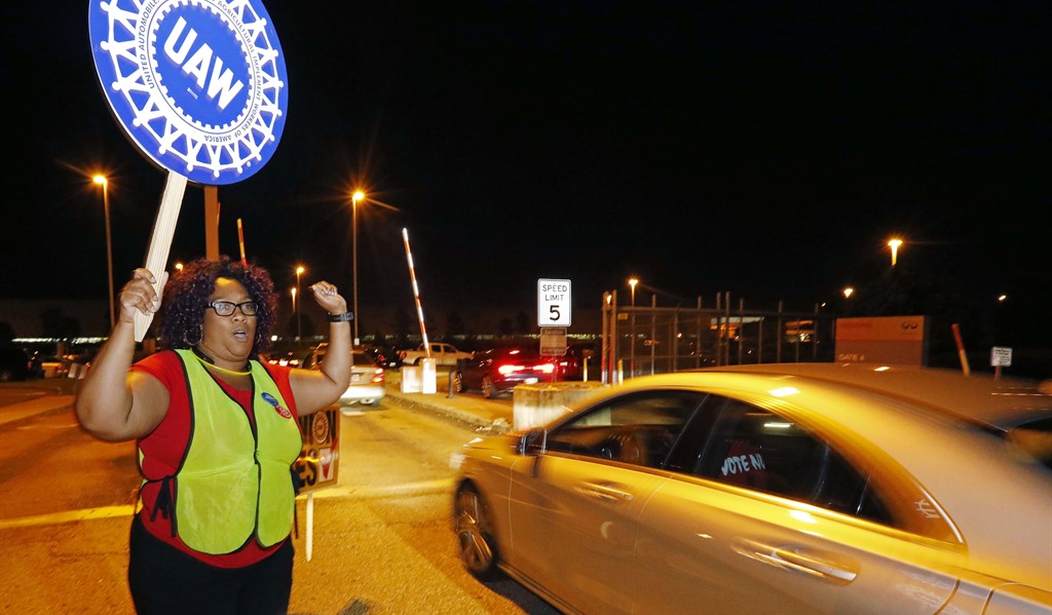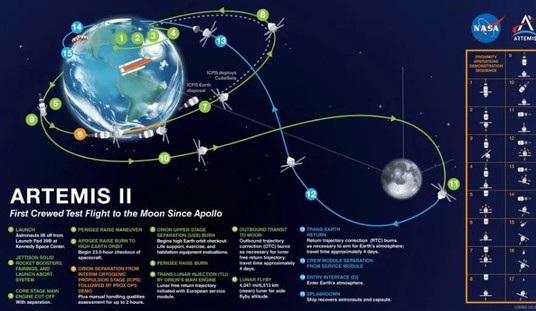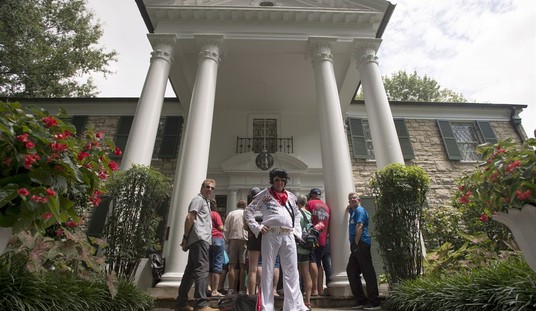Countin’ down to Strike Day – 11:59 p.m. September 14 – we are. The United Auto Workers is rallying the troops and “practicing” striking.
"Are you tired of being driven down?" "YES!"
"Are you ready to strike?" "YES!"#StandUp #UAW #solidarity pic.twitter.com/ByinrFNppX— UAW (@UAW) September 12, 2023
Rah-rah, huh?
UAW President Sean Fain was still making the network interview circuits and doing his best Miley Cyrus impression for all he was worth.
Shawn Fain, president of @UAW, went on CNN.
When asked if a strike could hurt the economy he said:
"It's not that we're going to wreck the economy. We're going to wreck their economy, the economy that only works for the billionaire class. It doesn't work for the working class." pic.twitter.com/84HrhnmvWu
— More Perfect Union (@MorePerfectUS) September 12, 2023
Well, for all the tough guy talk, schmaybe the negotiators for the UAW at the table working separate contract deals with Ford, GM and Stellantis (Jeep) – known as the Detroit or D-3 – took a moment to take a peek out the front door at the brewing Bidenomics carnage around them, gulped, and came back in for another round of talks a smidge chastened.
Because what they were demanding and busy shredding offers over last week…
…While handsome on its face, the GM offer was a good bit short of the initial 46% raise the union demanded besides missing a buttload of other things, and UAW president Sean Fain was quick to say , “Thank you, no.”
Well. Actually…
He shot back with more a version of “blow it out your tailpipe,” adding, for good measure, that he was “insulted.”
…they are actually willing to discuss modifying THIS week.
There’s been a change in temperature – a shift in the wind, if you will.
The United Auto Workers union is bending on its pay-increase demands, with recent proposals asking for a mid-30% raise, rather than the 40% increase the union initially targeted.
…Union negotiators recently offered proposals that include a mid-30% wage increase, and the sides have exchanged multiple offers in recent days, according to people familiar with the talks. The specifics of the latest proposals couldn’t be learned.
It is the first visible sign of progress on the wage issue since the sides began talks in earnest in July. UAW President Shawn Fain has slammed previous company proposals in his frequent livestreams, describing the offers as either inadequate or insulting.
…Under the current contract negotiated in 2019, full-time unionized factory workers start off at around $18 an hour, and can earn up to $32 an hour.
The union’s initial wage-increase demand was broken up into a 20% increase upon the contract’s ratification, and four additional 5% wage increases given each year. The actual wage bump would work out to 46% as those raises compound. However, the union and automaker typically compare wage proposals on a noncompounding basis.
Automotive News earlier reported that the UAW was lowering its pay-raise demands.
How about that? So while Fain is talking the big talk to his members, the reality check at the table is hitting their negotiating team.
Not everyone is clued into the economic ramifications of a simultaneous strike against 3 major automakers at one time..
Remember when the UAW negotiated a contract that nearly bankrupted the major automakers and the taxpayers bailed them out? Remember how GM was about the only company taxpayers lost money on in that bailout? I do. https://t.co/MoPC8DhZKn https://t.co/WqsB0VyJIw
— Chris Manning (@Manning4USCong) September 12, 2023
Pennsylvania’s senate bowling team captain weighs in, based on his extensive work history..
NEWS: Fetterman statement on @UAW:
"If the Big 3 can find money in the couch cushions to bump executive pay by 40% over the past few years, they sure as hell can find the money to give hard-earned raises to the people who actually build the cars and trucks Pennsylvanians drive." pic.twitter.com/m6L8xMPDsy
— Joe Calvello (@the_vello) September 11, 2023
(Why do I call him that?)
They should have asked the rest of the bowling team what THEY thought. https://t.co/18FmDlbjab
— tree hugging s*ster 🎃 (@WelbornBeege) September 12, 2023
Anyways, there’s always that latent sense of urgency as far as the administration is concerned.
Biden 'Not Worried' About Major UAW Strike On Automakers https://t.co/qOoTs7US4D
— zerohedge (@zerohedge) September 4, 2023
In the near term, if negotiations go south in the next day or so, analysts are saying a shorter strike might clear the car lots out, as the D-3 has an average of about 50 days’ worth of stock on already sitting on lots.
…“Our theoretical math suggests that labor cost increases should largely be manageable for the D-3. Further, a work stoppage should keep inventories low and support prices staying elevated, which should be a near term offset for higher wages,” RBC Capital Markets analyst Tom Narayan said Thursday in an investor note.
But, obviously, the effects across the breadth of the industry – not just the assembly lines themselves – would be far-reaching, and times are hard enough as it is. The question is how far the UAW is willing to push the envelope before they’ll agree to new terms.
…What “matters most” is the duration of a potential strike, Jefferies analyst Philippe Houchois said. In an investor note Monday, he estimates each week of a strike could account for 4% to 5% of adjusted earnings at Ford; 3% to 4% at GM; and 1.5% to 2% at Stellantis.
Simultaneous national strikes against the Detroit automakers, which the UAW has alluded to doing, would be unprecedented. It could have a ripple effect on the automotive supply chain, U.S. economy and domestic manufacturing. It also would likely tally into billions in losses for the companies in production, sales and other earnings.
The UAW is facing an industry in transition – Tesla’s costs right now for EVs they actually sell, unlike the D-3s models, are about $45hr vs the $66hr the UAW is getting right this moment. The labor increase will quite possibly double that if they get anywhere near what they’ve been demanding, for an industry heading in the direction of needing 40% less workers going into the next electric decade.
…The reality, according to Ford Motor Company CEO Jim Farley, is that it takes 40 percent fewer workers to make an electric vehicle than one with an internal-combustion engine. So, to use some back-of-the-envelope math, if baseline employment in the auto industry would, on average over the next ten years, have amounted to 1.2 million jobs, then the wholesale switch to EVs would cost 480,000 jobs.
Of course, they’re fighting for their lives. How they do in the next 48 hours or so will give some indication of whether they have the leadership to take them there or if they wreck the whole thing to pieces.







Join the conversation as a VIP Member